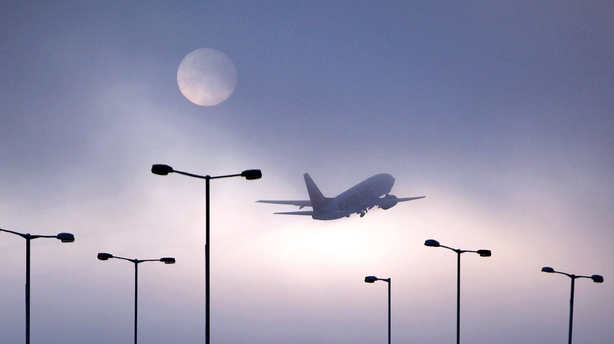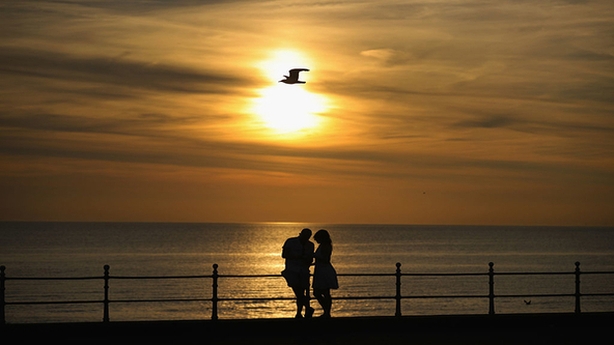They say that St Patricks' Day marks the start of the tourism season into Ireland – that being the point at which the number of visitors here starts to rise, on the way to its summer peak.
But it’s fair to say that Easter marks the start of Ireland’s own tourism season – the point at which we really start to take trips of our own, either within the country or overseas.
And tourism-related companies have long made clear the importance of Easter in their operations.
As Easter can sometimes be in March, or very early April it can have a material effect on how much money airlines like Ryanair or Aer Lingus make in the first quarter or second quarter.
And in results they’ll specifically reference the timing of Easter as a reason for their performance being better or worse than it was a year before.
How many of us use our easter break to go abroad?
We need your consent to load this rte-player contentWe use rte-player to manage extra content that can set cookies on your device and collect data about your activity. Please review their details and accept them to load the content.Manage Preferences
The best way of measuring it is to look at stats from the Central Statistics Office for 2019 and earlier.
There’s two reasons for that:
Firstly, the tourism market hasn’t yet fully recovered from the impact of Covid. Depending on what part of the sector you’re looking at, things were around 70-80% of their pre-pandemic level last year.
The hope is that there will be a full recovery this year, but obviously it’s too early to say for sure.
So the figures from 2019 represent the last, full, normal year of data available to us.
Secondly, the 2019 data is also the most recent detailed data we have.
That’s because the CSO would normally conduct surveys in airports and ports to understand who was travelling where, and the reasons for that. But they had to stop doing that at the start of the pandemic, and they haven’t resumed those surveys yet.
So, looking at the data we have for April 2019, we can see just over 745,000 people travelled overseas in that month.
That’s a jump of close to 18% when compared to March of the same year – and that kind of trend is repeated as you go back to the figures from the years before.
The only recent exception was 2016, when Easter was in March. In that year trips abroad actually fell in April.
And does that figure continue to grow throughout the summer months?
Yes - Easter really does kick off an uptick in the number of trips abroad, which continues to grow into the summer.
In 2019, for example, roughly the same number went abroad in May as in April, and then the number jumped again in June, before reaching a peak in July and August.
We can also see from separate CSO data that more of the people travelling in April are holiday-makers.
In the first three months of the year in 2019 about 58% of overseas trips were for holidays. The rest were to do things like visit friends or relations, or business trips.
But between April and June nearly 68% of trips were for holidays.
So more trips, and more of them for leisure.
What do we know about where people are going during Easter?

It’s a bit harder to pin down data on this.
We know in general that Britain is consistently a popular destination for Irish travellers.
In part because so many of us have family connections there – and Easter might be a good time to pop over to see people we haven’t seen in a while.
But also because it’s relatively cheap to travel, and it’s a relatively short trip, too. So it’s practical to head over for a weekend if you want to.
But sun holidays are also extremely popular at this time of year.
Figures from travel agents Click&Go show that around half of the bookings it has for Easter for this year are sun holidays.
Another quarter of its trips are city breaks.
Old faithfuls like Lanzarote, the Algarve and the Costa Del Sol are the most popular sun destinations, they said, and they pointed out that a lot of those areas are enjoying somewhat of an early summer.
Click&Go also said that its Easter bookings are up 40% compared to last year.
That reflects the recovery hoped for in the travel market this year.
However it may also indicate a shift in the broader travel habits of those who like sun holidays.a
As people will remember, Europe experienced a heatwave last year, with some popular holiday destinations hitting the high 30Cs, and some even shifting in the 40Cs.
Because of climate change the prediction is that this isn’t an anomaly – it’s the new normal.
So perhaps people are starting to shift their sun holiday to Easter time, where the "normal" summer temperatures now are.
What about city breaks?
According to Click&Go, Prague is the most popular destination for a city trip – followed by Rome and Berlin.
London and Edinburgh are actually a bit lower on the ranking, despite them being that big closer. Though perhaps that is because many people taking a short trip across the Irish Sea would book directly, rather than going through a travel agent.
But in all of this connectivity is an important factor – because a lot of airlines’ summer schedules only kick in when the clocks change.
So if you were travelling last week there are a lot of destinations that wouldn’t have been available to you – or that bit harder or more expensive to get to.
But the summer schedules are now kicking in, which means people have a bit more choice for Easter.
And some even go as far as the US. New York is the most popular destination on the other side of the Atlantic.
And 10% of bookers go on a cruise too, according to Click&Go, which probably wouldn’t be the first thing that comes to mind for this time of year.
Interestingly it said that a sizable majority of these bookings – about two thirds – were made after January, so many of these trips were relatively last minute decisions.
Maybe that reflects people holding back in recent months because they wanted to see how their finances held up in the face of higher prices, and high energy costs, during the winter.
But it may also reflect the fact that while a summer holiday is almost taken for granted for some, many still see an easter trip as a kind of added bonus.
How many of us are planning domestic trips during the Easter holidays?

Many are planning domestic trips too… though, again, it’s hard to quantify the exact extent.
Even before Covid it’s not like someone from the CSO could stand in one place - like an airport - and get an idea of how many are going where.
All the same, we do know from research by Fáilte Ireland that 82% of consumers are planning a domestic trip this year – which is back on a par with pre-pandemic levels.
And we know from old CSO data that the domestic travel market traditionally picks up at this time of year.
The first three months of a year tend to be quiet, then April to June steps up – before, as usual, the Summer peak in July to September.
Across April and June of 2019, there were almost 2.9 million domestic trips. On average those trips were around two a half days long.
That is too big of a time period to pin it all on Easter, but the holiday definitely is a factor.
The Irish Tourism Industry Confederation says the domestic market is generally strong in Easter, as people take advantage of their children being off school.
But they also tend to see a step-change in the number of overseas visitors coming to the country.
How popular a destination is Ireland at this time of year and what nationalities are coming?
ITIC says that you generally see a pick up in visitors from Britain, France and Germany.
But the American travel market starts to pick up in April too. It’s still well off the peak it will hit in the summer, but it does start to pick up.
And ITIC said Easter is generally when you start to see the coach tours start up – which would often involve a week-long trip around the country.
And that’s reflected in the CSO data, too.
In April 2019 you would have had almost 940,000 visitors to Ireland – which is up more than 19% on the March figures… and it’s nearly 60% higher than the February figures for that year, so before the likes of St Patrick's Day would have drawn people in.
Britain alone accounted for nearly 340,000 of those visitors, with the rest of Europe making up around 365,000.
Most of the remainder were coming from the US – around 185,000.
The peak in American visitors tends to come a bit later, in June and July – but April really does build on St Patricks Day in terms of numbers.
What difference does it make where the visitor is coming from?

It’s significant.
People in the industry will tell you that different visitors tend to behave quite differently to each other.
And if you think about how you might treat different trips, it makes sense.
Just as Britain is a good destination for Irish tourists seeking a weekend break, the same applies in the other direction.
So, visitors from Britain tend to come to Ireland for a long weekend – or even just an overnighter.
And they tend to stick to the cities too –they might fly into Dublin, head into the city centre, and then head back to the airport after a night or two.
But American visitors are very different.
They’re coming from much further away, and spending a lot more to get here, so they tend to stay for longer to make all that travel worth their while.
And they tend to use that time to travel around the country a bit more.
They might do a few days in Dublin, but then they might go west in search of their ancestral home. Or they go north to get photos at a landmark like the Giant’s Causeway, or they head along some of the Wild Atlantic Way.
For many of them it’s a once in a lifetime trip – or at least a trip they’re only going to make a few times in their lives – so they try to pack as much in as they can.
And because it’s a big trip for them they tend to spend a bit more per night than a weekender from the likes of England.
And that means they’re of much more benefit to the economy – and particularly the local economies outside of places like Dublin.







